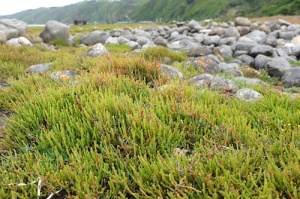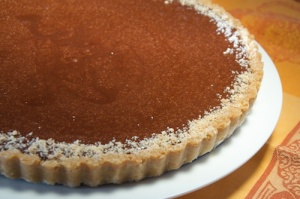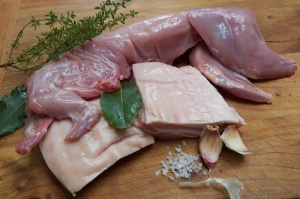I first came across marsh samphire in France on the Île de Ré where it grows alongside the island’s famous salt pans. The French call it salicorne, they pickle it in vinegar and use as a garnish for cold meats and terrines in much the same way as cornichons, the little baby gherkins.
I had no idea it also grew in New Zealand until chef Anthony North brought some to the City Market in Wellington. He had a bag of it under the counter – not for sale but to give away to like minded foragers and foodies. I’ve written about Anthony in NZ Life & Leisure (Mar/Apr 2013). He was at the forefront of the English foraging scene and has since discovered many of the same plants growing in his new hunting grounds in the Wairarapa. For the purposes of my story he took me to his favourite foraging places including the sea shore at Lake Ferry where we picked sea spinach and samphire. Last week I revisited the same spot with my husband Dan and our dog, confident we would collect enough of the salty-tasting plant to pickle a jar or two.
Dan reckoned he’d seen samphire growing on the shoreline much closer to home in Wellington. He said we really didn’t need to make an expedition of it but I much preferred the idea of foraging on the wind-blasted Wairarapa coast. And so we drove for miles to Lake Ferry, parked up on the gravel, searched the shoreline for a good hour and, unbelievably, found not a skerrick. I was quite sure we were in the right place and we were certainly in the right season but there was no samphire to be found. Maybe it was because the ground was so dry, or maybe the cattle had eaten it all. I wouldn’t have thought cattle had a taste for samphire but then they do like licking salt blocks and we did find plenty of cow pats dotted around.
The dog had the time of his life but we were windswept and grumpy so we retired to the Lake Ferry Hotel for a beer and a basket of fish and chips. On the way home Dan insisted we pull over on the shoreline at Petone. And there we found it – drifts of bright green samphire growing between the rocks at this unremarkable layby in Petone. Dan’s a good man. He resisted the urge to say ‘I told you so’, didn’t mention the tank of petrol we’d wasted, and patiently set to picking a bag of samphire for pickling.
Once found, samphire is unnmistakeable in appearance and flavour. It is a tiny little plant and it grows into a mass of succulent branches that break off at the nodes and taste like salty asparagus. You don’t need to pickle it; it can be simmered for 3 minutes then refreshed in ice cold water so it keeps its colour and crunch. Cooked like this it makes a tasty addition to mixed green or grain salads. It works well with seafood – try it with cockles and spaghetti or pan-fried fish and a beurre blanc sauce. I’m pickling mine so I can serve it atop some raw oysters for Christmas. Here’s the recipe:
Pickled Samphire
This quantity makes enough for a small preserving jar (as pictured)
120g samphire
1 ½ cups white wine vinegar
2 tablespoons sugar
10 peppercorns
¼ teaspoon mustard seeds
2 bayleaves
Wash the samphire in plenty of fresh water then blanch it in boiling water for about 1 minute. Drain and refresh in ice cold water and set aside.
Heat vinegar and sugar in a small pot over medium heat and stir occasionally until the sugar is dissolved. Add peppercorns, mustard seeds and bayleaves. Continue on the heat for another minute and then allow to cool down completely.
Pack the samphire into a sterilised jar and pour over the pickling liquid until it is close to the top of the jar. Seal the jar and keep for 3 weeks in a cool dark place before opening. Once opened keep in the fridge.























